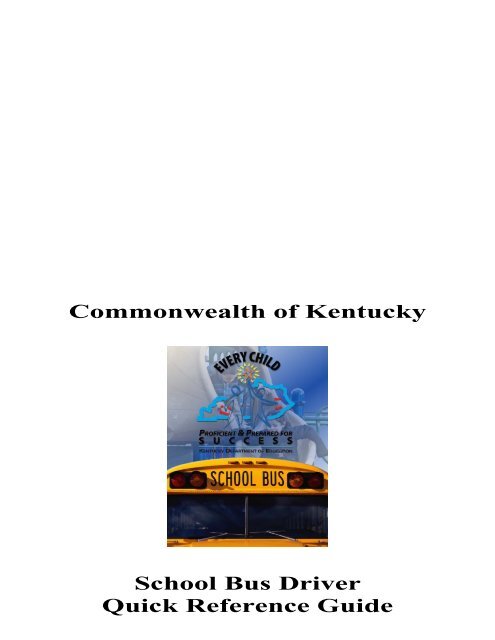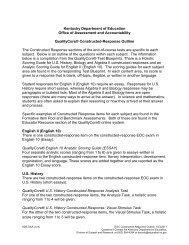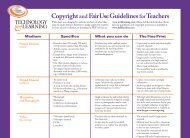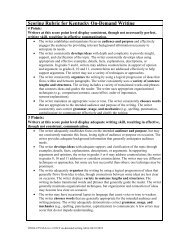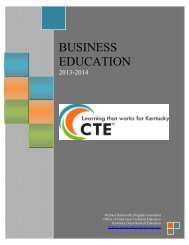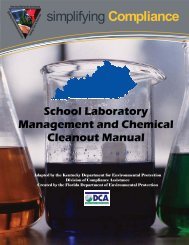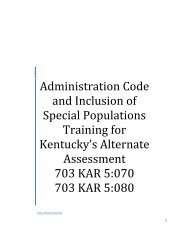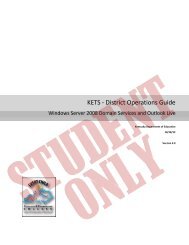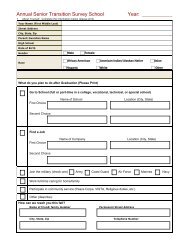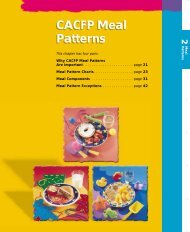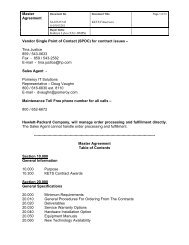Commonwealth of Kentucky School Bus Driver Quick Reference Guide
Commonwealth of Kentucky School Bus Driver Quick Reference Guide
Commonwealth of Kentucky School Bus Driver Quick Reference Guide
Create successful ePaper yourself
Turn your PDF publications into a flip-book with our unique Google optimized e-Paper software.
<strong>Commonwealth</strong> <strong>of</strong> <strong>Kentucky</strong><br />
<strong>School</strong> <strong>Bus</strong> <strong>Driver</strong><br />
<strong>Quick</strong> <strong>Reference</strong> <strong>Guide</strong>
STARTING DIESEL ENGINES<br />
I. Check all lubricants, cooling system levels and safety/operating equipment as required by pre-trip procedures.<br />
II. Set parking brake, have gearshift lever in neutral.<br />
III. Place engine shut-<strong>of</strong>f in run or on position.<br />
IV. Depress accelerator fully and engage starter to start engine.<br />
V. When engine starts, release starter switch immediately and reduce engine speed to less than 1,000 rpm’s. Warm<br />
engine three to five minutes, monitor all gauges during warm-up.<br />
VI. Do not increase the engine speed for at least three to five minutes.<br />
EMERGENCY TELEPHONE NUMBERS<br />
STARTING DEISEL ENGINES
ITEMS ALLOWED ON BUS<br />
I. What’s allowed<br />
A. Items which a student can securely hold<br />
and contain in their lap without<br />
impeding onto another passenger’s<br />
space.<br />
A. Band instruments allowed:<br />
Violin, viola, piccolo, flute, oboe,<br />
bassoon, clarinet (b-flat), alto clarinet,<br />
alto saxophone, tenor saxophone,<br />
trumpet saxophone, trombone, bells.<br />
B. Allowed but must be set on the floor<br />
between the feet <strong>of</strong> the student: Bassoon,<br />
bass clarinet, alto saxophone, trombone.<br />
II. What’s Not Allowed<br />
A. No glass objects or helium<br />
balloons<br />
B. No balloons<br />
C. No food or drinks.<br />
D. No weapons or anything that<br />
could be construed as a weapon<br />
E. No alcohol, drugs, or tobacco<br />
products<br />
F. No fireworks or any other<br />
explosive materials<br />
G. Anything that would likely block<br />
the bus aisles or exits<br />
*<strong>Reference</strong> 702KAR5:080 for<br />
Additional Restrictions
PRE-SCHOOL CHILDREN<br />
I. Local boards <strong>of</strong> education may transport 3 and 4 years olds who are enrolled in the preschool program.<br />
II. <strong>Bus</strong> must have trained driver assistant on board.<br />
III. Responsibility <strong>of</strong> driver assistant to receive and deliver child to parent, guardian, or person authorized<br />
by the parent in writing.<br />
IV. <strong>Driver</strong> assistant must escort child if crossing the road is warranted. Crossing the road (by student)<br />
should be allowed only after all other avenues have been explored.<br />
V. Radio appropriate school if parent or guardian is not home and wait further instructions.<br />
VI. Appropriate school will attempt to locate parent or guardian; if no contact can be made with parent or<br />
guardian, return the child to his/her school or prearranged location.<br />
VII. Contact director or transportation <strong>of</strong>fice if school or principal cannot be reached.<br />
ITEMS ALLOWED ON BUS<br />
PRE-SCHOOL CHILDREN
LOADING AND UNLOADING<br />
Each year, the majority <strong>of</strong> fatalities occur at, or near, school bus stops across the country.<br />
The transported student is in the greatest danger while waiting, boarding and exiting a school bus. The driver <strong>of</strong><br />
the school bus must follow proper procedures in order to give the most reasonable and safe protection to those<br />
school students for which he/she is responsible.<br />
THE STOP ARM IS TO BE UTILIZED AT ALL TIMES WHEN LOADING AND UNLOADING STUDENTS.<br />
THIS INCLUDES WHILE ON SCHOOL PROPERTY.
LOADING PROCEDURE<br />
The following step-by-step sequence should be used when loading students.<br />
APPROACH<br />
LOADING<br />
Step 1<br />
Step 2<br />
Step 3<br />
Step 4<br />
Visual Scan<br />
Tap Brakes<br />
Visual Scan<br />
Warning Lights<br />
Step 9<br />
Step 10<br />
Step 11<br />
Step 12<br />
Step 13<br />
Visual Scan<br />
Open Service Door<br />
Handrail<br />
Count<br />
Seating<br />
STOP<br />
DOOR<br />
Step 5<br />
Step 6<br />
Step 7<br />
Step 8<br />
Parking Brake<br />
Gear (Place in Neutral)<br />
Visual Scan<br />
Stop Arm and Red Lights<br />
Step 14<br />
Step 15<br />
Step 16<br />
Step 17<br />
Step 18<br />
Visual Scan<br />
Service Door<br />
Gear<br />
Parking Brake<br />
Visual Scan<br />
LOADING AND UNLOADING
PLANNING AND RESPONSIBILITY FOR EXTRA-CURRICULAR TRIP<br />
I. Gather Information<br />
A. Departure time/pick up point<br />
B. Destination<br />
C. Stops<br />
D. Number <strong>of</strong> Students<br />
E. Contact Person<br />
F. Manifest<br />
G. Problem-causing situations<br />
H. Estimated time <strong>of</strong> return<br />
II. Responsibilities <strong>of</strong> the <strong>Driver</strong><br />
A. To obey all safety regulations.<br />
B. To conduct or review with the students the emergency evacuation procedures before the beginning <strong>of</strong><br />
the trip.<br />
C. To maintain passenger control.
D. To control and react to emergency situations.<br />
E. To maintain safe vehicle conditions.<br />
F. To select or have input in deciding rest, food and fuel stops.<br />
III. Responsibility <strong>of</strong> Group Leaders/Chaperones<br />
KRS 161, 185 (1) Board <strong>of</strong> education shall require a member <strong>of</strong> the school faculty or a member <strong>of</strong> the<br />
administrative staff to accompany students on all school-sponsored or school-endorsed trips. (2) Boards<br />
<strong>of</strong> education may permit a non-faculty coach or non-faculty assistant, as defined by administrative<br />
regulation promulgated by the <strong>Kentucky</strong> Board <strong>of</strong> Education under KRS 156.070(2), to accompany<br />
students on all school-sponsored or school-endorsed athletic trips. A non-faculty coach or non-faculty<br />
assistant shall be at least twenty-one (21) yeas <strong>of</strong> age, shall not be a violent <strong>of</strong>fender or convicted <strong>of</strong> a<br />
sex crime as defined by KRS 17.165 which is classified as a felony, and submit to a criminal record<br />
check under KRS 160.380.<br />
A. To relay trip plans and safety precautions.<br />
B. To provide passenger information.<br />
C. To maintain passenger control.<br />
D. To provide supervision.<br />
E. To account for all students.<br />
F. To provide passenger instructions.<br />
G. To ensure ample supervision <strong>of</strong> students as to number and age group, KRS 161.148 Requires all persons<br />
who have supervisory responsibilities over students to have a criminal record check.<br />
*Notice: Out <strong>of</strong> county trips are limited to 2/3 seating capacity.<br />
PLANNING AND RESPONSIBILITY FOR EXTRACURRICULAR TRIP
BUS INCIDENT – PROCEDURES TO FOLLOW<br />
I. Secure the bus.<br />
II. Evacuate the bus if the students are in any danger.<br />
III. Survey the scene and evaluate situation.<br />
IV. Check and care for injuries – Calm passengers.<br />
V. Notify Director <strong>of</strong> Transportation – give location, number <strong>of</strong> injuries, type <strong>of</strong> incident, condition <strong>of</strong> bus,<br />
and emergency personnel needed (police, ambulance, fire department, etc.)<br />
VI. Have available: Manifest, CDL, physical card and pro<strong>of</strong> <strong>of</strong> insurance.<br />
VII. Supervise passengers.<br />
VIII. Assist emergency personnel.<br />
IX. <strong>Driver</strong> must be available for post accident drug testing if required.
REASONS TO EVACUATE BUS<br />
I. Emergency<br />
A. Fire<br />
B. Ruptured fuel tank<br />
C. Tornado striking the bus is imminent.<br />
D. Incident – <strong>Bus</strong> in immediate danger (bus should be visible in all directions 360°)<br />
E. At any other time passengers are in danger.<br />
II. Non-Emergency<br />
A. Fueling<br />
B. Required four (4) annual emergency evacuations drills.<br />
1. First week <strong>of</strong> school<br />
2. Any time before Christmas Break.<br />
3. First week <strong>of</strong> second semester.<br />
4. Any time before school is out.<br />
BUS INCIDENT – PROCEDURES TO FOLLOW<br />
REASONS TO EVACUATE BUS
WEATHER RELATED EMERGENCIES<br />
A. Tornado If you see a tornado while en route with pupils and the bus is in the path <strong>of</strong> the<br />
tornado, unload all pupils and proceed away from the school bus. Keep students<br />
in a group and find the lowest area (ditch), if possible. Instruct the pupils to get<br />
down on their knees, lie face down and cover their head with their hands. If the<br />
bus is exposed to hail and/or high winds, keep the students on the bus. Have all<br />
students stay in their seats with their chest on their thighs. Body parts should be<br />
below window height. Obtain clearance before proceeding to your destination.<br />
B. Earthquake If you notice an earth movement en route with pupils, stop the bus as quickly as<br />
possible in an open area away from falling objects. Keep all students on the bus.<br />
Obtain clearance before proceeding to your destination.<br />
C. Severe Weather If severe weather occurs while en route with pupils, park the bus in an area away<br />
from potential falling objects and remain there until the storm is over. Proceed to<br />
your destination. This type <strong>of</strong> occurrence will likely be the one the bus driver will<br />
encounter most frequently. It is advisable that while on your route, you should<br />
locate safe places to stop your bus in case <strong>of</strong> severe weather.<br />
D. Floods Do not attempt to drive through standing water with a school bus. Know your<br />
route and the areas where flooding may occur. Have an alternate route if this<br />
should occur. Inform the transportation department in the event a road is blocked<br />
and before an alternate route is used.<br />
E. Snow/Icy Conditions Monitor local radio and T.V. stations for school closings, delays or early<br />
dismissal. In the event this condition develops while en route, reduce speed and<br />
proceed with caution. If conditions are such you feel it is unsafe to continue, stop<br />
bus in safe location and get further instructions from Director <strong>of</strong> Transportation.
REMEMBER<br />
Your First Responsibility Is For The Student’s Safety<br />
If any <strong>of</strong> the aforementioned listed disasters should occur in your area, drivers may be put on alert for possible<br />
special assignment. The buses may be needed to move pupils from one school to another, to their home or to a<br />
prearranged evacuation point. Please keep in mind – in any emergency situations, report only those facts<br />
known to you. Be brief and concise in reporting your information. If it is an emergency situation, radio<br />
transmission needs to be kept to a minimum, so a coordinated effort can be conducted from the Central Office<br />
or Base.<br />
WEATHER RELATED EMERGENCIES
STUDENTS SHOULD FOLLOW THESE BUS RULES<br />
1. The bus driver may assign seats.<br />
2. Be courteous.<br />
3. No pr<strong>of</strong>anity.<br />
4. Do not eat or drink on the bus, keep the bus clean.<br />
5. Violence is prohibited.<br />
6. Remain seated.<br />
7. Keep all body parts inside the bus.<br />
8. Do not destroy property.<br />
9. For students’ own safety, do not distract the driver through misbehavior or by any other means.<br />
10. No person is allowed to stand in step well.<br />
11. No Standees are allowed.<br />
12. No person is allowed to ride on doghouse.<br />
13. Be at the bus stop 5 minutes prior to its arrival.<br />
MISBEHAVIOR ON BUS:<br />
Penalty is at the discretion <strong>of</strong> the principal depending on circumstance. (May include removal from bus for 1 to<br />
10 days or permanent removal from bus). Serious misbehavior on the bus may be cause for punishment up to<br />
and including suspension or expulsion from school. <strong>Reference</strong> Local Board Policy.
DISCIPLINE REPORTS<br />
I. Document Discipline Problems on Behavior Reports<br />
A. Student’s name<br />
B. Student’s school<br />
C. <strong>Driver</strong>’s name and signature<br />
D. Infractions marked<br />
E. Date<br />
F. <strong>Bus</strong> number<br />
G. Get principal’s signature<br />
H. Copies to: Student, Principal, <strong>Driver</strong>, Transportation Director<br />
I. Document action taken on report<br />
II. <strong>Driver</strong>’s Authority<br />
A. Assign seats<br />
B. May remove student from bus en route (only in extreme circumstances). Check local board<br />
policy.<br />
C. Must maintain atmosphere conducive to providing a safe and comfortable ride for all students.<br />
STUDENTS SHOULD FOLLOW THESE BUS RULES<br />
DISCIPLINE REPORTS
PROCEDURES TO FOLLOW FOR FIGHT ON A SCHOOL BUS<br />
DRIVER SAFETY FORMULA<br />
SKILL<br />
KNOWLEDGE<br />
CONDITIONING<br />
CONCENTRATION<br />
I. Stop the <strong>Bus</strong><br />
A. Pull the bus <strong>of</strong>f the road (safety first)<br />
II. Evaluate the Situation<br />
A. Students involved<br />
B. Safety <strong>of</strong> other students<br />
C. Radio the dispatcher<br />
III. Use A Calm, Stern and Authoritative Voice<br />
A. Give specific commands<br />
B. Do not yell<br />
IV. Separate the Students<br />
A. Position yourself between students involved while not placing yourself in harms way<br />
B. Use your body more than your hands<br />
V. Remove Participants to a Neutral Location on <strong>Bus</strong><br />
A. Dismiss the audience
VI. Get Medical Attention if Necessary<br />
VII. All Attempts Fail<br />
A. Radio dispatcher to send proper authorities<br />
VIII. Describe Incident in Writing to Transportation Director<br />
PROCEDURES TO FOLLOW FOR FIGHT ON A SCHOOL BUS
WEAPON/ARMED PERSON<br />
Each district should adopt specific procedures (policies) relating to their needs:<br />
If the bus should attempt to pull over or proceed on to the school.<br />
If the situation occurs in a rural or suburban area.<br />
Radio codes should be developed by each district to be used so that passengers and intruder will be less<br />
alarmed.<br />
IF A WEAPON IS SUSPECTED<br />
Be vigilant but do nothing to create a more dangerous situation.<br />
Radio situation only if it can be done in code. This code should alert Base to notify police for assistance and to<br />
notify the superintendent. Limit the number <strong>of</strong> people who have this information.<br />
Mimic bus trouble and stop en route in as safe an area as possible. (You may need to evacuate students).<br />
IF A WEAPON IS VISBLE<br />
Be vigilant but do nothing to create a more dangerous situation.<br />
Radio situation only if it can be done in code. This code should alert Base to notify police for assistance and to<br />
notify the superintendent. Limit the number <strong>of</strong> people who have this information.<br />
Follow instructions <strong>of</strong> person with the gun or other weapon.<br />
Attempt to keep bus atmosphere calm.<br />
Attempt to negotiate the release <strong>of</strong> students.
BOMB THREAT<br />
Every pre-trip and walk-around inspection should include keeping your eyes open for anything that has been<br />
tampered with or is out <strong>of</strong> place. If you believe there is anything unusual about your bus, you should report it<br />
immediately to the transportation director/head mechanic/designated person. You should also request police<br />
assistance.<br />
BOMB THREAT ON BUS EN ROUTE/BOMB FOUND ON BUS EN ROUTE<br />
Radio situation and location only if it can be done in code.<br />
Attempt to learn the following:<br />
When is the bomb going to explode<br />
Where is the bomb located<br />
What does the bomb look like<br />
What will detonate the bomb<br />
Negotiate to stop bus and evacuate students.<br />
Negotiate to notify police/bomb squad/EMS.<br />
Negotiate. Negotiate. Negotiate.<br />
WEAPON/ARMED PERSON<br />
BOMB THREAT
TWO-WAY RADIO PROCEDURES/CELL PHONE USAGE (EMERGENCY ONLY)<br />
INTRODUCTION<br />
The two-way radio is an important method <strong>of</strong> communication in the Transportation Department. It is<br />
imperative this radio only be utilized to advise pertinent information or emergency situations. The Federal<br />
Communications Commission (FCC) regulates radio use and proper use is a condition for licensing.<br />
A base station has been installed at the bus garage. The garage will be identified as Base and the Central Office<br />
radio will be identified as Central Office in most cases.<br />
RADIO PROCEDURES – PROPER USAGE<br />
• Check before each trip to ensure that the radio is on and the volume is set at an appropriate listening level.<br />
• Listen for conversation already in progress. Do not interrupt an ongoing conversation, unless you have an<br />
emergency.<br />
• When transmitting, hold the microphone approximately two (2) inches from your mouth. Key the “mike”<br />
and pause 1 ½ to 2 seconds before speaking. Think before speaking! Do not yell into the “mike,” use a<br />
normal voice.<br />
• State your information as briefly and concisely as possible. State all addresses and telephone numbers<br />
clearly. Speak slowly when giving addresses and telephone numbers.<br />
• Be pr<strong>of</strong>essional! Keep the language clean. Keep the transmission pertinent to Transportation business. Do<br />
not transmit personal business over the radio.<br />
• Acknowledge messages with 10-4 (message received, OK, yes) or negative (no).<br />
• The person who initiates the conversation should identify their unit first, and then the bus or location they<br />
are calling.<br />
EXAMPLES:<br />
1-2-9 (or <strong>Bus</strong> 1-2-9) to Base<br />
OR<br />
Base to 5-1 (or <strong>Bus</strong> 5-1)<br />
OR<br />
5 (or <strong>Bus</strong> 5) to 1-3-0 (or <strong>Bus</strong> 1-3-0).
RADIO PROCEDURES – IMPROPER USAGE<br />
• Avoid using “CB” phrases such as “Over and Out,” “Wilco,” “Gotcha Ears On” Keep all transmissions<br />
pr<strong>of</strong>essional.<br />
• Conducting personal business or using unauthorized code words or numbers.<br />
• Requesting phone calls to be made that serve no purpose or are not Transportation business.<br />
EXAMPLES:<br />
Having Base to call a day care center to inform them you will be there in 3 or 4 minutes.<br />
- By the time this call is made, in most cases the bus has arrived at its destination.<br />
Having Base to call a house to tell the occupants you will be 5 minutes early or late.<br />
CELL PHONE USAGE<br />
No driver may use a cellular telephone, <strong>of</strong> any type, while the bus is in motion and transporting one (1) or more<br />
children, except for communications made to and from a central dispatch, school transportation department, or<br />
its equivalent when the bus in not equipped with a functioning two-way radio. A driver may use a cellular<br />
telephone in a bona fide emergency.<br />
TWO-WAY RADIO PROCEDURES
DRIVER DRUG AND ALCOHOL TESTING<br />
Definitions<br />
Drugs<br />
Alcohol<br />
Refers to controlled substances as prohibited by the Omnibus Act, including, but not limited to:<br />
1. Marijuana<br />
2. Cocaine<br />
3. Opiates<br />
4. Amphetamines<br />
5. Phencyclidine (PCP)<br />
Refers to intoxication agent in beverage alcohol, ethyl alcohol, or other low molecular weight<br />
alcohol, including, but not limited to, methyl and isopropyl. Alcohol use includes the<br />
consumption <strong>of</strong> any beverage, mixture, or preparation, including medication containing alcohol.<br />
The Omnibus Transportation Employee Testing Act <strong>of</strong> 1991 is the federal law that requires school bus drivers<br />
to be covered under a comprehensive drug and alcohol testing program. Effective in January 1995, the law<br />
requires the following test:<br />
Pre-employment. Drug testing only<br />
Post accident;<br />
Random (50% annually);<br />
Reasonable suspicion;<br />
Prior to return to work after misuse.<br />
Employees are prohibited from performing safety-sensitive functions under following conditions:<br />
Consumption resulting in prohibited levels <strong>of</strong> alcohol in the system;<br />
Within four hours (4) after using alcohol;<br />
Within eight hours (8) after an accident if their involvement has not been discounted as a<br />
contributing factor, and they, have not been tested;<br />
When a test reports the presence <strong>of</strong> a prohibited drug or prohibited amount <strong>of</strong> alcohol.
ALL APPLICANTS WHO REFUSE DRUG AND ALCOHOL TESTING<br />
SHALL BE TERMINTATED IMMEDIATELY FROM EMPLOYMENT CONSIDERATION.<br />
The regulations require a drug test for beginning school bus drivers, bus mechanics and other district personnel who drive<br />
a bus. The law also requires a drug/alcohol test for school bus drivers who are involved in an accident.<br />
A school bus driver shall immediately report to the local superintendent or designee the revocation <strong>of</strong> his or her driver’s<br />
license, conviction for DUI/DWI or conviction <strong>of</strong> reckless driving.<br />
Employees required to undergo testing shall take a drug/alcohol test at the place designated by the superintendent or<br />
designee immediately after the accident. In the event the employee is confined to the hospital for treatment <strong>of</strong> injuries<br />
arising out <strong>of</strong> the accident and is unable to report to the testing facility, the employee shall take the drug/alcohol test at the<br />
treating hospital.<br />
If the employee is taking prescription medication(s), the bottle, vial or container issued by the pharmacist shall be brought<br />
to the facility administering the drug/alcohol test a the time <strong>of</strong> the test. The employee and medication(s) shall be reviewed<br />
individually and an evaluation shall be made by the testing facility, regarding the medication(s) potential adverse effects<br />
on safe performance.<br />
DRIVER DRUG AND ALCOHOL TESTING


